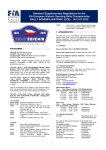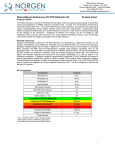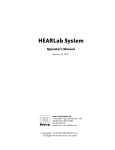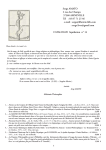Download Epifani Performance series Specifications
Transcript
(partial) Alphonso Johnson ● Andrew Gouché ● Oteil Burbridge ● Anthony Jackson ●Darryl Jones (Rolling Stones) ● Joel Cataldo ● Antonio Righetti ● Lincoln Goines ● Mike Pope Carlito Del Puerto ● Matthew Garrison ● Pino Palladino ● Carlos Del Puerto Dario Deidda ● Dominique DiPiazza ● Christian McBride ● Mike Pope ● Mark Dresser Oscar Cartaya (Spyro Gyra) ● Richard Bona ● Daniel Vinec ● Oscar Stagnaro ● Tony Garnier (Bob Dylan) ● Rob Derhauk (moe.) ● Daniel Pearson (Clay Aiken) ● Frode Berg Joel Smith ● Anthony Wellington David Buda (Boston Pops) ● Tony Lewis (Prologue) David Garcia ● John Benitez ● David Marotta ( LA Session Bassist) ● Greg Rzab (The Black Crowes) ● Ruben Rodriguez ● Rob DeSantis ● Steve Epstein (Velvet Jones Band) Andy Jordan ● Seth Meidenman ● Brent Pearen ● Joe Aranda ● Tony Mahone George Traviani ● Kern Brantley (Beyonce) ● Phil Palumbo ● Maurice Fitzgearlod Lynn Davis ● Vashon Johnson (Shania Twain/B.B. King) ● Lee Nadel (Carbondale) Eric Holden (Josh Groban) ● Jerry Barnes (Chic) ● Stanley Banks (George Benson) Malcolm Prescott ● Luis Rivera ● Joe Gallant ● Steve Zerlin ● Bo Bradley Gabriel Nicholson (John Love) ● John Flitcraft ● Michael “Tiny” Lindsey (MichaelTolcher) Rashon Alexander ● Bernard Bell (Gap Band) ● Stacy McGee (Ginuwine) Lamont McCain (DJ Logic) ● Anthony Corley ● Bryant Wilder ● Drew Lustman ● Max Laredo Ole Gunnar ● EIkeland ● Dwayne Wright ● Sammy Sanfilippo ● Bernie Minoso Raul Bernal ● Tim Lyons ● Peter Falbo ● Philip Simmons ● Ryan Owens (Robbie Seay Band) Ivan Santiago ● Jin Kim ● C. Togbah Outland ● Stefan Held ● Jared Morante ● Jerome Gaw Ruben Austin ● Enrico Brazzale ● Kenneth J. Schweighardt ● JJ Plasencio Brian Buracker ● Ricardo Gil Martino ● "Hope" Vacca ● Cem Tuncer ● Josh Porter Joe Cambra ● Jonathan Floyd ● Jean-Yves BLaquiere ● Tom Szell ● Rick Van Benschoten JC Alza ● Bobby Turner ● Moises Maldonado ● Nick Lazarev ● Waldo Martínez www.epifani.com 68 34th St. B 68 34th St. Brooklyn, NY 11232 PH. 718.832.4664 FAX: 718.965.3770 Performance Series Operation Manual The Epifani Family PS 600 PS 410 PS 210 PS 115 PS 112 Specifications – Speakers Table ofContents Contents able of Introduction Table of Contents Table of Contents Important Safety Features Table of Contents Performance Series Front Panel Features Table of Contents Rear Panel Features Getting Started able of Contents Connections • • • • • PS 600 PS 410 PS 210 PS 115 PS 112 PS 210 • 2x10" 400 Watt Proprietary Drivers • 1" Compression Tweeter • 17 Ply Baltic Birch Cabinet - Dado joint construction • High impact locking corners • Steel recessed handles • 1/4" phono and Speakon inputs connectors • 18 gauge radiused steel grill • Freq. Response 40Hz - 16 KHz • Sensitivity 99db 1W1M • 18 1/2" H x 23 "W x 18" D • Powering Up PS 115 • 15" 400 Watt Proprietary Driver • 1" Compression Tweeter • 17 Ply Baltic Birch Cabinet - dado joint construction • High impact locking corners • Steel recessed handles • 1/4" and Speakon inputs • 18 gauge radiused steel grill • Freq. Response 36Hz - 16 KHz • Sensitivity 97db 1W1M • 21.5" H x 23 "W x 18" D • 52 lbs. 53 lbs. Dialing In Your Sound Rear Panel operation Speaker Cabinets Specifications The Epifani Family Welcome to the Epifani family of owners and thank you for your purchase. Our sole Mission is to design innovative products that inspire musicians of all skills and styles to challenge their creative boundaries. It's really very simple - to play your best you need to sound your best. PS 410 PS 112 • 4x10" 200 Watt Proprietary Driv- • 12" 300 Watt Proprietary Driver ers (800 watts) • 1" Compression Tweeter • 1" Compression Tweeter • 17 Ply Baltic Birch Cabinet - dado • 17 Ply Baltic Birch Cabinet - dado joint construction joint construction • High impact locking corners • High impact locking corners • Steel reinforced "Comfort Feel" • Steel recessed handles strap handle • 1/4" phono and Speakon inputs • 1/4" phono & Speakon inputs connectors • 18 gauge radiused steel grill • 18 gauge radiused steel grill • Freq. Response 45Hz - 16 KHz • Freq. Response 36Hz - 16 KHz • Sensitivity 98db 1W1M • Sensitivity 102db 1W1M • 16.5" H x 19.5" W x 16.5" D • 28.5" H x 23" W x 18.5" D • 36 lbs. • 79 lbs. We hope you enjoy your Epifani purchase and, should you ever need service, you can feel confidant that we put as much pride in supporting our products as we do designing and building them. Love the way you sound! -- Nick Epifani 2 11 Speaker Cabinets Introduction Performance Series Cabinets The PS Series cabinets were designed and built with the same commitment to sonic detail and quality construction as our award winning UL Series speakers. Tuned for a more "classic" tone than the UL Series, they deliver thick lows with a musically crisp edge. Only the best conventional materials were used in construction: 17 ply Baltic Birch cabinets, polypropylene capacitors in the crossovers, Neutrik SpeakOn connectors, steel magnet drivers made exclusively for Epifani in the USA, steel recessed handles and high impact locking corners. We recommend the use of high quality speaker cables that use Neutrik SpeakOn connectors when plugging your amp into the cabinet. These connectors provide more contact area and you eliminate the risk of crossing positive to ground and damaging your amplifier. Once you’ve connected your cabinet you can adjust the tweeter to driver level using the tweeter level adjustment knob on the rear panel of the cabinet. Your PS cabinet should come with the tweeter level at the “12:00” position. This is simply a starting point. Many players actually prefer to back it off as the tweeters are extremely efficient. The Performance Series The Performance Series were first introduced at the Winter NAMM Show 2006 to critical acclaim. The design goals for the line were to offer uncompromised sonic quality at an affordable price. Utilizing many of the design elements found in the UL Series line, the Performance Series maintains its own unique sound and look. Nick Epifani and his design team employed all types of scientific disciplines in designing the Performance Series products. Working together on the acoustical, mechanical and electrical engineering aspects of the line, they focused on creating an amplifier solution where the whole is greater than the sum of the parts. All of the components are carefully selected to meet strict design and manufacturing specifications. The Performance Series solution is really an integrated audio system whose major components were designed to interact with one another to ensure optimum performance Important Safety Features WARNING RISK OF ELECTRIC SHOCK DO NOT OPEN Specifications PS 600 • 600 watts @ 4 Ohms • Passive/Active input select • 3 band shelving EQ • Treble Shift • Mid Cut Selector (footswitch accessible) • Mid Cut Level Adjust • Mute (footswitch accessible) • Master Volume • DI out w/level, Pre/Post EQ select, ground lift • Tuner out, Pre-amp out • EFX sends and returns (series or parallel) • Speakon output connector • 8lbs 10 3.5" H X 19" W X 11" D Warning: TO REDUCE THE RISK OF FIRE OR ELECTRIC SHOCK, DO NOT EXPOSE THIS APPARATUS TO RAIN OR MOISTURE. Caution: TO REDUCE THE RISK OF FIRE OR ELECTRIC SHOCK DO NOT REMOVE THE COVER. NO USERSERVICEABLE PARTS INSIDE. REFER SERVICING TO A QUALIFIED SERVICE PROFESSIONAL The lightning flash with arrowhead symbol within an equilateral triangle is intended to alert the user to the presence of uninsulated dangerous voltage within the product's enclosure that may be of sufficient magnitude to constitute a risk of electric shock to persons. The exclamation point within an equilateral triangle is intended to alert the user to the presence of important operating and maintenance (servicing) in the literature accompanying this device. 3 Rear Panel Operation Important Safety Features 1) Read these instructions. 13) Damage requiring service: Un- 2) 3) 4) 5) plug the apparatus from the wall outlet and refer servicing to qualified service personnel under the following conditions. a) When the power supply cord has been damaged. b) If liquid has been spilled, or objects have fallen into the apparatus. c) If the apparatus has been exposed to rain or moisture. d) If the apparatus does not operate normally by following the operating instructions. Adjust only those controls that are covered by the operating instructions as an improper adjustment of other controls may result in damage and will often require extensive work by a qualified technician to restore the apparatus to its normal operation. e) If the apparatus has been dropped or damaged. 14) When the apparatus exhibits a distinct change in performance this indicates a need for service. 15) Object and Liquid entry: Never push any foreign objects of any kind into the openings as they may touch dangerous voltage points that could result in fire or electric shock. The apparatus shall not be exposed to dripping or splashing and no objects filled with liquids such as a beverage Keep these instructions Heed all warnings. Follow the instructions. Don not use this apparatus near water. 6) Clean only with a dry cloth. 7) Do not block any ventilation openings. Install in accordance with the manufacturer's instructions. 8) Don not install near any heat sources such as radiators, heat registers, stoves, or other apparatus that produce heat. 9) Do not defeat the safety purpose of the grounding type plug. A grounding type plug has two blades and a third grounding prong and is used for your safety. 10) Protect the power cable from being walked on or pinched particularly at the plugs or at the point where they exit the device. 11) Unplug this apparatus during lightning storms or when unused for long periods of time. 12) Refer servicing to all qualified service personnel. Servicing is required when the apparatus has been damaged in any way, such as the power cable has been damaged or liquid has been spilled or objects have fallen into the apparatus or the apparatus has been exposed to rain or moisture, does not operate normally or has been dropped. The rear panel of your Epifani amp has several useful features that, when used properly, will enhance the overall experience with your amp. 1. Tuner out - Plug an instrument cable between this jack and your digital tuner. You can use the Mute Switch on the front panel to access the quiet tuning mode. Tuning quietly makes everyone around you happy and being in tune will help advance your career! 2. Effect Send/Return - Using shielded instrument cables connect the "Effect send" to your effect's input. Connect the output of your effect to the UL Amp Series "Effects Input". Using the Serial/Parallel switch you can choose run your effects "in line" with the dry signal or "along side" of the dry signal. Typically a reverb would be run in parallel and a chorus or flanger would be run in series. To practice along with pre-recorded music you could take the output of a tape player, CD player or MP3 player and plug it into the effect return jack. 3. Pre-amp out - Using a shielded instrument type cable this output could be used to send a signal to a power amp or to send an unbalanced signal to a recording device. 4. Direct Out - Using a "microphone" cable with XLR connectors you can send a balanced signal to the house PA or for direct injection into a recording device. 5. Direct Out Level - You can control the volume of the Direct Out jack for the cleanest possible feed to an external device. 6. Pre/Post switch - By placing the switch in the "pre" position you are essentially sending an unenhanced or "flat" signal out of the Direct Out. In the "post" position the Direct Out is outputting the EQ settings you have chosen. Unpacking your unit IMPORTANT NOTE: Your Epifani product was originally packaged in a specially designed carton and included special packing materials. Please save these items. They should be used when shipping your Epifani product. Please inspect the shipping carton - If the packaging seems damaged please return this item to the shipper. 4 9 Powering Up Front Panel Features *Before turning your amplifier on always set the "Master Volume Control" to the zero position. This will prevent damage to your speakers in the event of a product failure or faulty input signal. 1 3 4 11 9 12 7 1. Turn the amplifier on using the power switch located in the upper right hand corner of the amplifier front panel. In the "on" position the indicator on the front panel should be illuminated blue. Upon power-up the mute feature will engage. 2. Turn the volume on your instrument to the loudest position. 3. Next, set the EQ controls (bass, mid, and treble) to zero (twelve o’clock position) and begin playing aggressively while turning up the Gain control of the appropriate channel (as indicated by the LED peak indicator light). When the LED light is green there is still potential to increase the Gain. When the light turns red your input is too hot and your signal will distort. For the cleanest sounding results, allow the LED indicator to turn red intermittently (only while playing at the most aggressive levels). 4. Next, turn the Master Volume Control clockwise to the desired listening volume. Note: make sure the Mute button is not engaged. At this point you should be hearing your instrument amplified through the system. Congratulations! You're only a few steps away from hearing your instrument's true, natural character. 2 1) 2) 3) 4) 5) 6) 7) 8) 9) 10) 11) 12) 5 6 8 10 1/4” Phono Plug input Passive/Active Selector Pre Amp Gain Knob Adjusts the input signal to the appropriate level. Bass Control – Adjust the amount of low frequency Midrange Control – Adjusts the amount of midrange frequencies Treble Control – Adjusts the amount of high frequencies Treble Shift Selector This feature “shifts” the Q point from 3 KHz to 6 KHz ) Mid Cut Selector – engages the “Mid Cut” Circuit Mid Cut Control – determines the amount of mids to be cut Mute – mutes the entire amplifier Master - Master volume Power – turns the unit on or off 5 8 Rear Panel Features 1 3 Getting Started 4 11 9 7 12 1A Now that you've become acquainted with the features of your new Epifani Amplifier it's time to actually experience the product. To operate this product to it's fullest potential please read these instructions thoroughly. Warning! - BEFORE PLUGGING YOUR UNIT IN FOR THE FIRST TIME READ THE FOLLOWING SECTION CAREFULLY. AC outlet voltages vary from country to country. Make sure that the voltage in your area meets the voltage requirements printed on the apparatus (e.g., AC 230V 50 Hz or AC 120V 60Hz.) Make sure that the voltage selector is set in the proper position for your area. Failure to do so could result in harm to your amplifier and void the warranty. 5 Connections 6 8 2 10 13 socket. 1) 1 A) AC Line-in - Firmly plug the supplied AC power cable into the FUSE 2) USA/European Power Select Switch- Select 120V for use in the USA and Canada Select 3) Amp Out with “Speak-On” connector – Connect your amplifier to the speaker cabinet 220V for European use. using ommend the Inch connec- 4) 5, 6, 7) a Speak-On cable. *NEVER connect plus or minus to ground – (i.e. we highly r e c use of a “Speakon to Speakon” for a better connection. In the event of a Speakon to ¼ tion, be sure the connection from the amp to cabinet is made while the amplifier is OFF. Pedal Control- Allows you to Mute and engage the Mid-Cut features via the optional foot switch. Effect Send/Return- This feature allows you to use outboard effects with the Ultra Light Amp. Effects Send/Return - Can also be run in series or parallel via the selector switch (6). 8) Tuner Out- Connect your tuner using an instrument cable. While in mute mode you can silently 9) Preamp Out- Use this feature to bypass the power section of your PS 600 and use an alternate 10) Pre/Post EQ- Selects whether direct output (DI) signal comes before or after EQ section. 11) Direct Out Level - Adjusts the signal coming from Direct Out (Usually kept at the twelve o'clock 12) Direct Out (XLR) - Send a balanced signal to house sound or sound engineer (Can be used as tune. power amp. position). Adjust accordingly in conjunction with different applications (recording, live, etc). 6 a “record out” for studio applications). 13) Ground Lift- Disconnects chassis ground to reduce 60 cycle hum. 1. Remove the AC cable from the package and firmly insert the female end in the AC receptacle located on the back panel of your amp. 2. With the amplifier in the "OFF POSITION" plug the male end of the AC cable into the wall outlet. 3. Connect the speaker using either the "Speakon™ or 1/4" phone jacks on the rear panel. Make sure that you are using an "unshielded" speaker cable and that the polarity of the cable is correct. Do not use a shielded instrument cable to connect speakers to an amplifier. 4. *NEVER connect plus or minus to ground – (i.e. we highly recommend the use of a “Speakon™ to Speakon™” for a better connection. In the event of a Speakon™ to ¼ inch connection be sure the connection from the amp to cabinet is made while the amplifier is OFF. Note - (If you've purchased an Epifani Combo amp the primary speaker connection has already been made.) 5. Now you can connect your instrument to the amplifier. Make certain that you are using a "shielded" instrument cable to connect your instrument to your amplifier. If you are unsure of the type of cables you currently own, then we advise you take a trip to your local music store and purchase the appropriate cables. 6. Plug your instrument into the input jack on the front panel and select either the Passive or Active setting depending the output of your bass. 7















